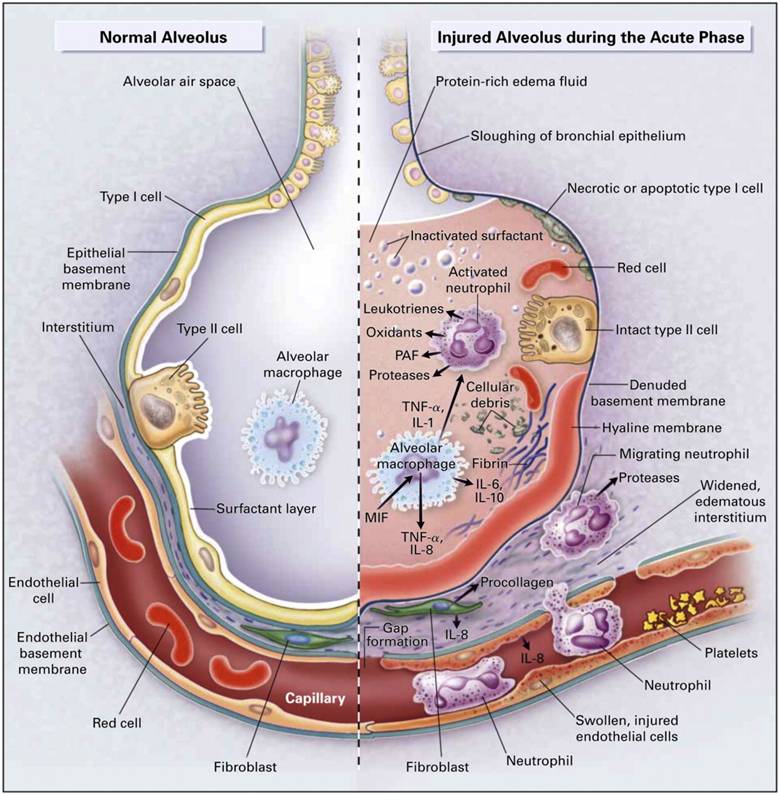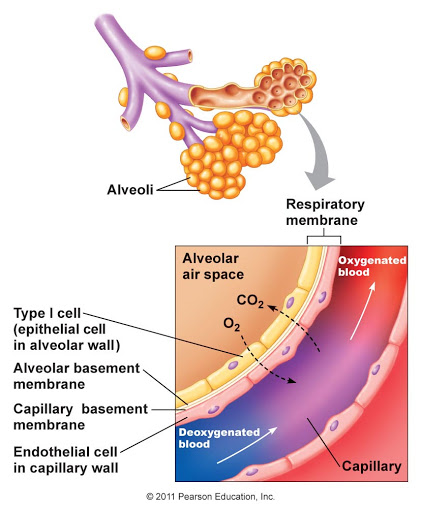Lung Damage
 Why do some people who contract the COVID-19 viral infection die?
Why do some people who contract the COVID-19 viral infection die?
Simply speaking, they die because of respiratory failure that occurs because the respiratory surfaces of the lungs are irreversibly damaged.
To understand this better, here is a brief overview of how the lungs function.
- When you inhale, air passes through your nose and mouth into your windpipe. The air then travels to air sacs or alveoli (little balloons) in the lungs.
- Small blood vessels called capillaries run around and through the walls of the air sacs.
- When you exhale, air passes from the blood, to the alveoli and up the air passages to through the nose or mouth.
- When the air that you inhaled reaches the alveoli, the oxygen in the air passes through the air sac walls and through the blood capillaries walls and into the blood, filling the blood with oxygen.
- At the same time, carbon dioxide moves from the blood capillaries into the air sacs and to the lungs for you to exhale.
- This bidirectional process is called gas exchange, and occurs across the respiratory interface or alveolar-capillary membrane.
 Respiratory failure occurs because the lungs cannot efficiently exchange gas into and out of the body - the oxygen coming in or the carbon dioxide going out.
Respiratory failure occurs because the lungs cannot efficiently exchange gas into and out of the body - the oxygen coming in or the carbon dioxide going out.
When the oxygen in the lungs cannot get into the blood, causing low blood oxygen levels, but the carbon dioxide levels are near normal, this is called hypoxemic respiratory failure.
When the carbon dioxide in the blood is not able to get out for exhalation, but the blood oxygen level is near normal, this is called hypercapnic respiratory failure.
The Pathology:
The respiratory interface or alveolar-capillary membrane across which gas is exchanged must be very, very thin to allow air to diffuse across it.
It is normally about 0.25 µm or 250 nm thick, about 5000X smaller than the thickness of plastic wrap which is about 12.7 µm thick. So pretty incredible and fragile!
As you can imagine, if this interface gets too thick, gas exchange will not occur efficiently.
In the case of COVID-19 infection, there seems to be a progressive consolidation (gumming up) of the lung tissue that causes respiratory failure and death.
Early findings shown by CT scans of the lung tissue show “ground glass opacities” that appear to start in the periphery of the lungs and histological findings show edema of the lung tissue and white cell infiltration. Basically the air balloons are clogged up with fluid, extra cells and scar tissue.
That means that the respiratory interface or alveolar-capillary membrane across which gas exchange is to occur is way too thick to allow anything to pass across.
This means that the infected person is having a really hard time breathing and is basically suffocating despite making all the movements characteristic of breathing.
No air can go into the lungs because none is coming out. It’s like a significantly severe asthma attack or choking episode.
The process that underlie the damage and tissue changes are not 100% known but resemble those changes found in another severe respiratory condition ARDS – Acute Respiratory Distress Syndrome.
Further details and pathological findings although fascinating is beyond the scope of this article.
Why Do We Need Ventilators?
One thing that humans cannot live without air! We just have to breathe.
There are stories and a documentary about fishermen who can hold their breath, go without air, for >10 minutes without issue, but they have trained for that. Most of us can barely hold our breaths for 30 seconds without passing out.
Without oxygen, the lungs become air starved and there is air hunger and the skin, lips and fingertips will turn blue. The heart will start to beat irregularly and the brain will not function well and the person exhibits confusion, sleepiness, loss of consciousness.
Depending on the severity of the oxygen deprivation, extra oxygen is provided through the nose, via a mask over the nose and mouth, or via a tracheostomy tube down the throat and into the windpipe.
The lung damage caused by the COVID-19 infection cause respiratory failure so the only thing that could be done to potentially save the life of someone infected is breathing for them, provide them with oxygen support.
This is done with mechanical ventilation in the ICU – intensive care unit, under sedation.
The goal of mechanical ventilation is to get oxygen into the blood and carbon dioxide out of the blood.
Briefly, the ventilator pushes warm moist air with > 21% oxygen into the lungs of a sedated patient.
The pathology caused of the COVID-19 makes it such that not only the percentage of oxygen has to be high, but so does the air pressure being forced into the lung to get across the now thickened respiratory interface.
This is a very traumatic procedure and one that can cause additional damage when the pressures needed to oxygenate the blood is too high.
In addition, some patients may not improve after treatment on the ventilator and may need the machine to continue to breathe for them as long as they are alive.
Many patients get lung infections – pneumonias- or suffer lung collapse from being on the machine.
Even after recovery, the lungs will not work as well for a long time, and the patient will have shortness of breath, get exhausted easily and be prone to lung infections.
Moreover the tissue changes that cause damage may never heal and there will be scarring of the lungs that cause that section of lung to not work, be unable to be inflated.
Many older persons are dying because they have a diminished lung capacity before getting the infection.
Many younger persons, especially with underlying respiratory issues are at higher risk of getting a severe infection.
Even those without underlying respiratory complaints can be compromised depending on the way the virus interacts with their respiratory system preferentially.
I hope this brief article answers your questions and convince you that this infection is not benign and is not something to take lightly.
Please continue to isolate if you have any respiratory symptoms.
Please stay at home to prevent contracting and/or transmitting the infection.
Stay Safe and Healthy using the tips suggested before!